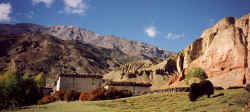MyHimalayasimpressions from |
|
|||||||
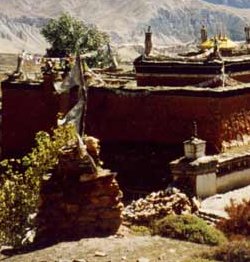
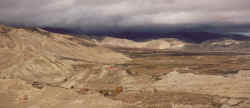
The 'Plains of Prayer' are a stretch of fertile land surrounded by barren rocks
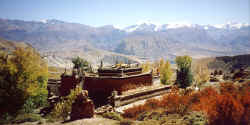
Lo Gekar, Place of Virtue is a beautiful monastery surrounded by yellow
trees and red bushes.
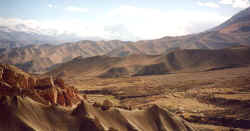
Rock formations above the village Tangmar.
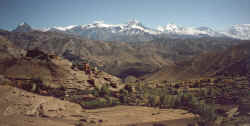
Gelung in one of few villages that is not built like a fortress, the room of
protector deities overlooks the village is is worth a short detour.
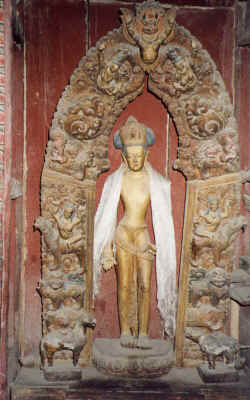
Old wooden statue somewhere in Mustang..
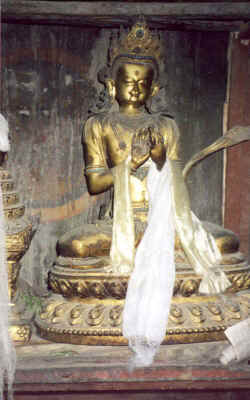
Old statue somewhere in Mustang..
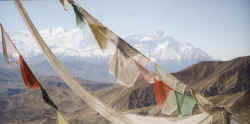
Prayerflags in front of Annapurna I, Tilicho and Nilgiri
Upper Mustang: Lo Mantanag - Lo Gekar - Tetang
Lo Gekar - Tamar - Tetang
Lo Manthang- Lo Gekar - Tamar
We get up early to clear up the mess we've created in the chapel room. Half an hour later the room looks like a holy place again and after breakfast we set out for what will be a most spectacular day.
In the warm autumn morning, we leisurely walk up pastures where pass three women who use a mortar to grind juniper branches into a powder of incense. A feeling of sadness overcomes me when I look back at Lo Manthang. But since I think of Lo Manthang as just an interesting village and don’t see it as the absolute highlight of our trek, leaving is not so hard. The route back will be on the same side of the Kali Gandaki, the eastern part is less inhabited and therefore more strenuous. Even drinking water is hard to find there, which can make walking days very long.
Slowly the 'Plain of Prayers’ disappears, after two hours there’s no indication that hidden in one of those rugged valleys lies such a jewel as Lo Manthang.
The distractive view of the Himalayan range in front of me and the training from the last days makes walking very easy, even climbing the highest pass Lugri La (4'200 m) doesn't take much effort. A small creek flows down the other side, after the dry scenery it is a welcome change to see grass, flowers and bushes. The monastery of Lo Gekar lies between bushes and yellow birches. Not only its location is pleasant, the interior is what makes it really the nicest monastery we have visited in Mustang. It’s also one of the oldest and most important gompas. It was here, at the 'Pure virtue of Lo', where the first hidden scriptures of Padmasambhava were found. He hid his teachings all over the Himalayan region, thus making sure that they remained undiscovered in times of danger for Buddhism. In the anteroom we are greeted by tiles of Buddha Sakyamuni and Bodhisattvas. The Gonkhang is situated before the main room, the different protectors are covered with sheets and shown only once a year during a special festival. Dozens of butter lamps illuminate the main room, making the many statues even more beautiful. The main statue is Padmasambhava, to each side are his two Yoginis Yeshe Tshogyal and Mandarava. In the small room to the left are more of similarly wonderful figures, my favourite one is a statue of a Green Tara.
The village is far down the valley and nobody seems to be here except for the kitchen crew which is already cooking. Hopefully they prepare another great dal baht. There must be something wrong with my stomach, I eat huge quantities of food but three hours later I’m already starving again. I just love rice and lentils and - upon special request - get it at least once a day. I don’t mind having it for lunch and dinner. The others are not eager to have it that often, only Jeanine shares my taste. Alexander declares that 'of the 8 people in our group, 3 are vegetarians, 2 of them even being dalbahtarians'.
By the time we have a lunch a big number of children have gathered and watch us. Despite the fact that Lobas are considered poor, malnutrition is not a problem so I don't feel too guilty eating a third portion of dal baht while the kids stare at my plate with big eyes. Describing them as poor just because they don’t earn much money is arrogant anyway. They own nice houses, have fields for agriculture and husbandry and enough to live decently, look well-groomed (with the exception of children) and seem to be happy. Of course their lives are very hard, but despite that they appear to be satisfied.
I make do without the well-deserved siesta and leave with the kitchen crew. After half an hour I stand at the foot of a pass, once up there it almost knocks me out. Behind rugged valleys and canyons the glaciers and snow-capped peaks stretch from left to right. I'm overwhelmed. It can't be the view alone, I find the mountains in Switzerland impressive but they never evoke such emotions. It can't be the sheer size and height of the mountains, it is probably the long walking that makes me more receptive. The sun beats down but the heavy wind that blows in my face keeps the temperatures pleasant. Out of curiosity I spit in the air, the wind carries it 12 m uphill.
Very slowsly I stroll down towards the next pass, enjoying every step. The path goes through a natural gate, but it would be stupid to hurry down to the camp instead of using every minute to appreciate the view. I climb a small hill to the right of the pass and stand there with my mouth and eyes wide open, the view is simply breathtaking. I sit down and stare at it for a long time. Below me opens a deep valley, I stand on top of whitw stonepillars which are followed by yellow dunes and red cliffs further south. On the right hand side are small patches of terraced fields, the whitewashed houses of Tamang look like lego between golden birches. Far behind ice and snow stretch on the horizon. The number of colours and forms is overwhelming, yet it all fits together perfectly and looks harmoniously. And again, words fail to describe it.
I'm not the only one who is touched by all the beauty we have seen today, most of the group are also overwhelmed to have experienced such a day. Just as we think this can't be topped and get ready to climb down a few yaks are driven down from the, passing us with the mountains in the background. The scene is almost too idyllic to be true.
After a short but very steep walk down the yellow canyon we reach the village Tamar. Ist fields are situated in the southern and western part of the valley, big vertical red cliffs build the north-western part. The yaks are given time to rest and graze on a patch of grass. After the barren landscape with few different colours this combination of red rock, blue sky, green grass and a white yak is almost too much. A haystack near our camp is the most comfortable viewpoint. This is the 8th day since our departure from Jomosom, and it’s hard to imagine a more perfect one.
I think I start to understand the humbleness of the people. After the miserable rainy day we got to enjoy wonderful weather and amazing scenery. Sudden changes like this make you grateful, and it is the absence of anybody you can actually thank that invokes people’s wish for some 'higher power'.
Above the village are a number of caves waiting to be explored. After climbing a steep gravel slope Charles and I reach a few lower caves. But even they are impossible to reach unless you're a rock climber, the entrance is too high up. We climb deeper into the canyon until it becomes so narrow that we have to return. The bigger rocks are solid, but the smaller ones crumble and slide down the hill, I’m happy to be back down safely. At the entrance of a canyon we find a strange looking chorten, the top looks like a bush with hundreds of prayer flags woven into. Around the chorten are hundreds of erected stones, something I've never seen before. The absence of wind and sound add to the eerie atmosphere. It's dusk already, people are in their houses, the gompa is closed and the short walk through the village reveals nothing exceptional.
What a day!
Tamar – Gelung – Shyangboche
Another clear and cloudless day expects us when I open the tent, Nilgiri is in gloaming light. It has become humid in the morning and is still quite cold where the sunrays haven't reached yet. We pass more caves on our way south, a gradual ascend takes us up a hill. What a surprise, we're already above Gemi and see the town, the long mani wall and the pass we've climbed five days before. That long and steep trail looks harder and longer than it actually felt climbing it.
Most of our local companions were unhappy that we stayed in Tamar and not in Gemi. The dancing and drinking was a welcome change for them, I don’t know what else happened that night, supposedly some have girlfriends there now.
On the way down to Gemi I remember the good time I had there. And I absolutely want to meet that Tibetan girl who works for the Japanese Project. My expectations won't be fulfilled, chances are tiny. But it's worth trying, and I don't have to blame myself later for not trying. In the meantime I've reached the river and found a bridge. I'm still thinking about how to find Dawa when...I see her sitting on a boulder near the dzong. It looks as if she's waiting for somebody, probably Tenzing. He denies having walked to Gemi the night before, but I don’t know how to read the smile on his face when he says it.
A minute later I meet the monk who explained the making of butter figures a few days ago, his heartily welcome makes Gemi an even more familiar place. I try to find the house of Pema Tsering’s mother to tell her the exchange rate of Swiss Francs so he won’t be ripped of but can’t find her. All this takes some time, the group has to wait in the shade under the trees outside Gemi and enjoys the beautiful weather.
Two more passes need be crossed before lunch, which will be good for my appetite. In relation to the strenuous climb, Gemi La doesn't offer much of a view, the next one is easier to ascend and offers a spectacular view of the Annapurna range and Nilgiri. It's the same view we've had a few days earlier, but today the weather is even better. Shortly after the pass we reach Jamyung, which lies at the fork to Gelung and Shyangboche. After regular lunch plus two plates of dal baht and an energy bar I feel ready for the detour to Gelung. It's just down the valley and a pleasant walk, the two gompas come closer fast. As if to protect the village they are built above it. The paintings of the lower one, Tashi Chöling, have recently been renewed by a local artist. It's a small but fine monastery, the atmosphere reminds me of Lo Gekar. Monks are preparing tormas for tomorrow's puja, moulding and painting figures made of butter.
As in many parts of Tibet and Ladakh, the Gonkhang - room of the protectors - is situated in a separate building. Only men are allowed to enter this temple which is dedicated to a powerful protector deity. A young monk opens a cupboard which contains statues of Mahakala in different sizes and materials. It represents the Buddhist form of Shiva and it is hard to believe that this scary looking creature which tramples on a human body is another manifestation of Avalokiteshvara, the Bodhisattva of Compassion. It is important to know that despite their frightening depiction every single of the eight Dharmapalas is there to protect people and not to harm them. 'The Big Black One' is also the subject of most paintings on the wall. Another cupboard remains closed, the statue in there is displayed only once a year. I get the impression that somebody tried to make this room as scary and eerie as possible. Together with rest of the inventory it has the wanted effect; old weapons, ancient guns, shields, a chain mail and a thief's hand look spooky. On the way out Tenzing has a short argument with the monk, and while the monk refuses Tenzing rips off a small piece of the armour and gives it to me. Hopefully this won't bring bad luck!
The direct way from Jamyung to Shyangboche would be an easy walk, the way from Gelung is longer and goes uphill for quite awhile. At the nice chorten on the pass we get back on regular path again to Shyangboche whose three houses are just a few minutes away. The rain must have been heavier here than further north, the trail is full of dmud which has dried and is hard as stone now. Paths must have been impassable four days ago, and in fact we meet a group who encountered many problems and is two days behind schedule.
I get to enjoy the afternoon sun for one hour before it disappears behind the mountains which build the natural western border of Mustang. Mornings here seem endless, but afternoons are short because the sun sets early and the shade makes temperatures drop fast.
Shyangboche - Samar - Tetang
Hoar-frost covers the hills around us, wisely I've decided to sleep in the guesthouse again, the rattling of pots wake me in the morning.
The direct path to Samar runs high above the canyons, with every side valley we cross the Annapurna range is getting closer and closer. I expected an easy walk but a few gorges make it harder than it looked on the map. But since they are neither high or steep and the eyes are fixed on Tilicho and Nilgiri the climbs go by almost unnoticed. The same mountains are appearing higher and higher, the increasing vegetation contrast the walls of ice and make me realise just how massive those mountains are. The subtle variety of colours after the moonlike scenery is nice, some bushes are dark-green while others are reddish or yellow.
Two deep valleys need to be crossed before getting lunch in Samar. The rain washed down part of valley walls, the path is in good condition but I don't feel very comfortable when I look at the vertical 150 feet of mud, dirt and big stones. Who knows how solid it is after the rain, I increase my speed. At the bottom I catch up with Sabita. She stands still and doesn't look very happy: a yak is standing before the ford and looks directly towards her. Her relief to see me is not justified, if only she knew that even Swiss cows make me feel uncomfortable... I try to appear confident, yell at the yak and throw a few stones. To my surprise and relief the yak just leaves and we reach Samar a few minutes later. Our respect seems justified, Nima claimed to have been chased by the yak. She’s been riding on a horse today, a big ugly blister made walking too painful.
In the courtyard next to our lunch place two men have just killed a yak and are starting to skin it. They work fast, two hours later the yak is disembowelled and cut in pieces, the meat lasts for half a year. Because Buddhism forbids the killing of animals butchers are regarded as members of a lower class. Millers, blacksmiths and musicians have also been considered to be 'lower class'. But class is not as harshly interpreted as in the strictly organised caste system of the Hindus. It's more like in our societies where some professions are not regarded as highly as others.
The second part of the day is an easy downhill walk. As soon as Ghyakar appears, the trail becomes spectacular when it runs high above the gorge. We took the same way a few days ago, but it's still adventurous. There's no real danger because the path is broad, but when small stones hit the trail a few yards behind me I walk faster, well... admittedly I start to run after warning the people behind me. After a tea break at Chele we are in the river bed of the Kali Gandaki again. The ferocious wind from the south isn't blowing very strong which saves us from getting too much sand in our mouths, ears and noses. We reach Chusang much faster this time because we don't spend much time looking for fossils anymore.
We have been walking almost the same route just a few days earlier, but it feels like having been here much longer ago. Maybe the mind has been so busy processing our last four days that there was no room left for the time before that and that’s why those days seem more distant. Maybe it is simply that the time sense changes when walking and being on the move.
It is early afternoon, the bright light is gone and the sun colours the landscape in a soft yellow light. Since we are early we walk further than originally planned to make tomorrow’s hike shorter. Once again the distances on the map are totally wrong. Just 15 minutes later we arrive at Tethang‘s mani wall and beautiful chorten which has two auspicious symbols painted on each side. We camp below the village in a forest near the river. The bath in the cold water is rewarded with getting 'sun-dried' during the sunbathing afterwards. And another haystack calls for an afternoon nap. Simple things like nice weather, good food, restful sleep are enough to make me happy and satisfied.
The old dzong is lit beautifully in the evening sun but for once I'm not eager to see a village. It has gotten very windy, clouds are blown up here from Jomosom. So far we've been very fortunate with the weather, and it should stay like this because tomorrow's hard walk to Muktinath would be strenuous if not impossible in rain or snow.
|
Summary Part 4:
Leaving Lo Manthang is made easier by the great views on the climb to the highest pass, Lugri La 4'200 m. In a lovely green sidevalley to reach Mustang's most beautiful gompa, Lo Gekar. While walking to our camp snowed peaks take in the whole view on the horizon. The red canyons and green grass of Tamar are a welcome change after the days in the desert. From Gemi we follow a similar path down to the Kali Gandaki, enjoying the views of the Annapurna range. |

